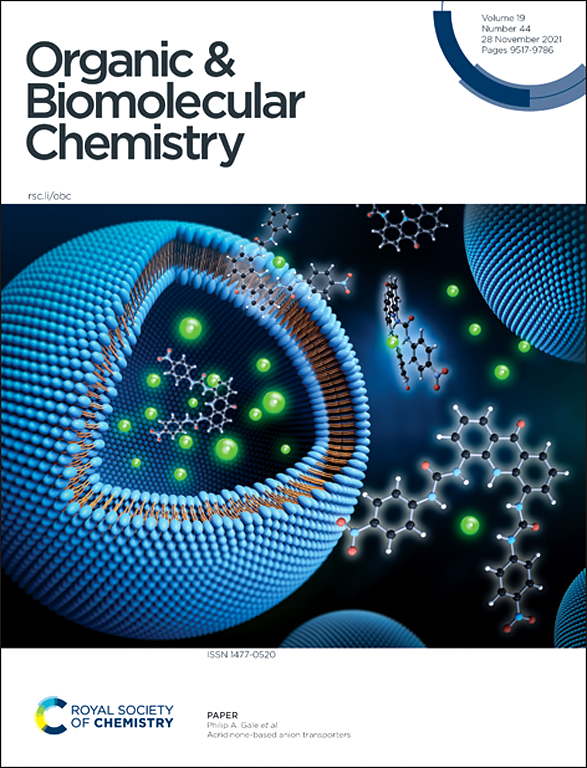一种含有 1,1-二氨基嗪的 NNN Pd(II) 夹板配合物:无受体脱氢偶联反应的多功能催化剂。
IF 2.9
3区 化学
Q1 CHEMISTRY, ORGANIC
引用次数: 0
摘要
我们一步合成了一种叠氮基、非醛基、中性 NNN-钳状配体,收率达 85%。在室温下于乙腈中使用 Pd(OAc)2 对配体进行钯化,通过简单、经济、直接的合成过程获得了钳形复合物,收率为 88%。该复合物的结构通过 1H NMR、13C NMR、傅立叶变换红外光谱和质谱法得到了证实。变温核磁共振光谱显示,该复合物即使在较高温度下也很稳定,这是钳形复合物的一个特征。生成的复合物被证明是一种多功能催化剂,可用于无受体脱氢偶联(ADC)合成 N-杂环:(i) 1,2-二取代苯并咪唑、(ii) 2-苯基喹啉、(iii) 2-苯基喹喔啉和 (iv) 2-苯基喹唑啉酮。由于反应的副产物是 H2O 和 H2 气体,因此该催化反应可被视为绿色催化过程。量子化学计算表明,在 ADC 反应的金属配体合作(MLC)过程中,可能存在腈-酰亚胺转换过程。本文章由计算机程序翻译,如有差异,请以英文原文为准。

An NNN Pd(ii) pincer complex with 1,1-diaminoazine: a versatile catalyst for acceptorless dehydrogenative coupling reactions†
An azine-based, non-palindromic, neutral NNN-pincer ligand was synthesised in a single step with an yield of 85%. The palladation of the ligand, using Pd(OAc)2, was performed in acetonitrile at room temperature to obtain the pincer complex in 88% yield through a simple, cost-effective, and straightforward synthetic procedure. The structure of the complex was confirmed by 1H NMR, 13C NMR, FT-IR, and mass spectrometry. The variable temperature NMR spectra revealed the stability of the complex even at higher temperatures, a characteristic feature of pincer complexes. The generated complex proved to be a versatile catalyst for Acceptorless Dehydrogenative Coupling (ADC) to synthesize N-heterocycles: (i) 1,2-disubstituted benzimidazoles, (ii) 2-phenylquinolines, (iii) 2-phenylquinoxalines and (iv) 2-phenylquinazolinones. Since the side products of the reactions are H2O and H2 gas, the catalysis can be considered as a green catalytic process. Quantum chemical calculations indicated the participation of a possible nitrene–imide conversion process during the Metal–Ligand Cooperation (MLC) in ADC reactions.
求助全文
通过发布文献求助,成功后即可免费获取论文全文。
去求助
来源期刊

Organic & Biomolecular Chemistry
化学-有机化学
CiteScore
5.50
自引率
9.40%
发文量
1056
审稿时长
1.3 months
期刊介绍:
Organic & Biomolecular Chemistry is an international journal using integrated research in chemistry-organic chemistry. Founded in 2003 by the Royal Society of Chemistry, the journal is published in Semimonthly issues and has been indexed by SCIE, a leading international database. The journal focuses on the key research and cutting-edge progress in the field of chemistry-organic chemistry, publishes and reports the research results in this field in a timely manner, and is committed to becoming a window and platform for rapid academic exchanges among peers in this field. The journal's impact factor in 2023 is 2.9, and its CiteScore is 5.5.
 求助内容:
求助内容: 应助结果提醒方式:
应助结果提醒方式:


